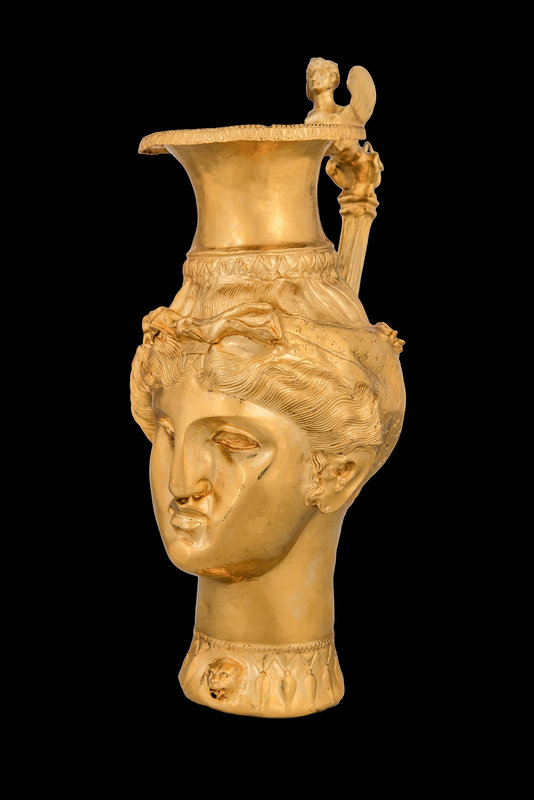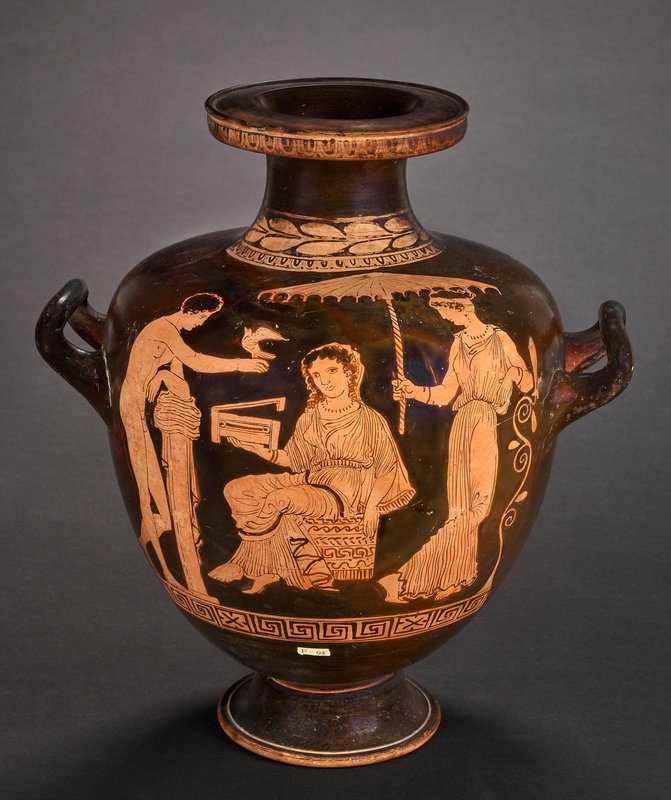Major exhibition on luxury in the Persian empire: 'Luxury and power: Persia to Greece' opens at the British Museum
LONDON - This major exhibition at the British Museum will explore the relationship between luxury and power in the Middle East and southeast Europe between 550-30 BC. This was a period when the Persian empire of ancient Iran clashed with the cities and kingdoms of Greece before it was conquered by Alexander, king of Macedon, known to history as ‘Alexander the Great’.
Luxury and power: Persia to Greece moves beyond ancient Greek spin to delve into a more complex story of luxury and power in ancient Iran, Athens, and the world of Alexander.
Drawing on exquisite objects from Afghanistan to Italy, it explores how the royal Persian court used objects of exquisite luxury as markers of authority, defining a distinct style that was copied by different social classes throughout the empire. Early democratic Athens rejected Persian culture as decadent yet adopted luxury in intriguing ways. Alexander then swept aside the Persian empire and ushered in a new age in which eastern and western styles of luxury were fused.
Among the exceptional loans to the exhibition is the extraordinary Panagyurishte Treasure from Bulgaria. Accidentally discovered by three brothers in 1949, these treasures are outstanding examples of ancient metalworking and demonstrate the influence of Persian and Greek luxury across the Balkans. The Treasure consists of nine richly decorated gold vessels: eight rhyta used to pour wine and one bowl to drink it.
The Panagyurishte Treasure. Photo: © Todor Dimitrov/National Museum of History, Sofia, Bulgaria.
Panagyurishte Treasure, Gold Ram Head Rhyton. Photo: © Todor Dimitrov/National Museum of History, Sofia, Bulgaria.
Panagyurishte Treasure, Gold Hera rhytonized pitcher. Photo: © Todor Dimitrov/National Museum of History, Sofia, Bulgaria.
Panagyurishte Treasure, Gold Phiale. Photo: © Todor Dimitrov/National Museum of History, Sofia, Bulgaria.
Panagyurishte Treasure, Gold Goat Rhyton. Photo: © Todor Dimitrov/National Museum of History, Sofia, Bulgaria.
Panagyurishte Treasure, Gold Athena rhytonized pitcher. Photo: © Todor Dimitrov/National Museum of History, Sofia, Bulgaria.
Panagyurishte Treasure, Gold Amphora. Photo: © Todor Dimitrov/National Museum of History, Sofia, Bulgaria.
The exhibition will also feature objects from the British Museum collection, bringing together astonishing artefacts of gold, silver and glass. A gilt silver rhyton shaped as a griffin is a remarkable example of Persian craft. Originally used as a wine-pourer, this drinking vessel reflects the opulence of the Persian court.
Gilt silver rhyton with winged griffin protome. Possibly found at Altıntepe, eastern Turkey; 5thC BC-4thC BC, Achaemenid. Gilt silver; height 23 cm; diameter 13.40 - 14.50 cm; weight 891.00g. British Museum, London. Bequeathed by Sir Augustus Wollaston Franks in 1897. © The Trustees of the British Museum
Alongside these stunning Persian vessels will sit Athenian examples of drinking vessels, influenced by their Persian contemporaries. A pottery rhyton, crafted in the form of a lion’s head, demonstrates how ancient Greece emulated and incorporated styles of precious-metal luxury from the Persian court.
Red-figured handled cup in the form of a lion's head, pottery, Capua, Italy, 500-470 BC. British Museum, London. © The Trustees of the British Museum
Also from the Museum’s collection will be a gold wreath from Turkey, similar to those found in elite tombs in the kingdom of Macedonia. The gold oak wreath, consisting of two branches with a bee with two cicadas, showcases the spread of luxury across the region and how styles evolved into the period after the death of Alexander in 323 BC.
Gold oak wreath, said to be from the Dardanelles region (Turkey), about 350-300 BC. British Museum, London. © The Trustees of the British Museum
(Dr) Jamie Fraser at the British Museum, said: “Traditionally, we have viewed the Persians and their apparently “decadent” love of luxury through the eyes of their enemies, the Greeks. This exhibition is a chance to explore beyond these biased accounts and understand how Persians wielded luxury as a political tool across a vast and complex empire.”
(Dr) Henry Bishop-Wright at the British Museum, said: “This exhibition is a superb opportunity to explore different notions of luxury across the Persian, Greek and later Hellenistic worlds; particularly, how they interrelate and inform contemporary attitudes. It’s incredibly exciting to display the Panagyurishte Treasure, a once-in-a-generation loan, in this wider context.”
Hartwig Fischer, Director of the British Museum, said: “Luxury and power: Persia to Greece provides a fascinating opportunity to look at the ways luxury influenced political power across Persia and Greece. The exhibition explores the people of the past and their way of life, from the highest elite of the Persian court to the ordinary citizens who were affected by them.
“I would like to express my gratitude to our exhibition supporters the American Friends of the British Museum; BullionVault; Julie Fitzgerald and Stephen Fitzgerald; and Steven Larcombe and Sonya Leydecker. I’d also like to extend my thanks to the Bulgarian Ambassador H.E. Marin Raykov as well as the National History Museum in Sofia. Without their support, we would not be able to present such exhibitions, allowing visitors to discover and experience cultures from around the world.”
4 May – 13 August 2023
Athenian drinking mug in the form of the head of a bearded Persian. The Persian Class, Greece, about 410–400 BC. British Museum, London. © The Trustees of the British Museum
Hydra showing a woman shaded by a parasol, pottery, Apulia, Italy, 400-380 BC. British Museum, London. © The Trustees of the British Museum
Millefiori glass dish, glass and gold, Canosa di Puglia, Italy, 225-200 BC. British Museum, London. © The Trustees of the British Museum.
Gilded silver plate, Iran or Afghanistan, probably Parthian or Early Sasanian, probably 2nd–3rd century. British Museum, London. © The Trustees of the British Museum.
Gold armlet (part of the Oxus Treasure), Tajikistan, 499–300 BC. British Museum, London. © The Trustees of the British Museum
Pottery rhyton in the form of a seated sphinx, attributed to The Sotades Painter, Greece, about 470–450 BC. British Museum, London. © The Trustees of the British Museum

/https%3A%2F%2Fprofilepics.canalblog.com%2Fprofilepics%2F1%2F0%2F100183.jpg)
/https%3A%2F%2Fstorage.canalblog.com%2F03%2F02%2F119589%2F96711876_o.jpg)
/https%3A%2F%2Fstorage.canalblog.com%2F11%2F31%2F119589%2F94773502_o.jpg)
/https%3A%2F%2Fstorage.canalblog.com%2F20%2F83%2F119589%2F94772815_o.jpg)
/https%3A%2F%2Fstorage.canalblog.com%2F26%2F72%2F119589%2F75604929_o.jpg)
/https%3A%2F%2Fstorage.canalblog.com%2F59%2F60%2F119589%2F26458628_o.jpg)






















/http%3A%2F%2Fstorage.canalblog.com%2F15%2F92%2F119589%2F117929349_o.jpg)
/http%3A%2F%2Fstorage.canalblog.com%2F71%2F87%2F119589%2F110418294_o.jpg)
/http%3A%2F%2Fstorage.canalblog.com%2F23%2F63%2F119589%2F35629056_o.jpg)
/http%3A%2F%2Fstorage.canalblog.com%2F43%2F11%2F119589%2F70580579_o.jpg)